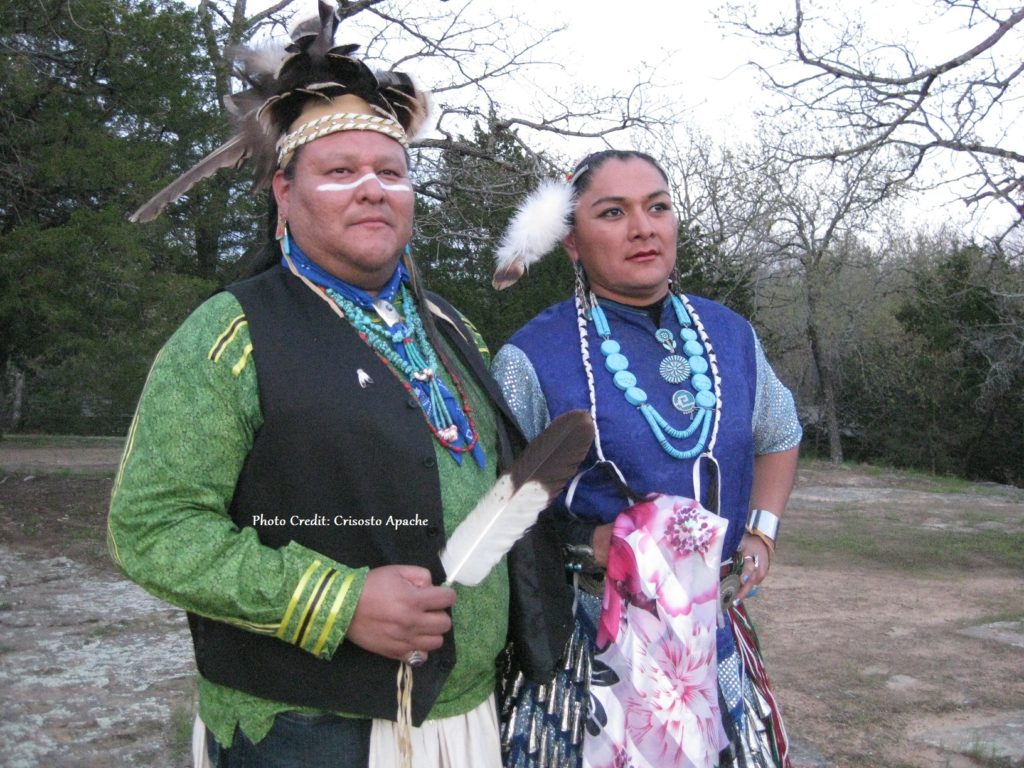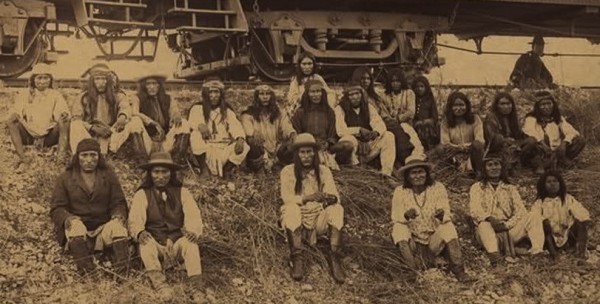
By Crisosto Apache
Originally published, December 8, 2011 on the Qualia Encyclopedia of Gay Folklife website by Mickey Weems.
https://web.archive.org/web/20151221155313/http://www.qualiafolk.com/2011/12/08/two-spirit/
Two-Spirit is an identity shared among First Nations Canadian and Native American LGBTQ people that situates same-sex orientation and gender variation within each nation’s cultural framework. Recognizing that many Native North American tribes view identities in their own way, the Two-Spirit community does not demand conformity to pre-set classification of Lesbian, Gay male, Bisexual, Trans, and Queer. Rather, Two-Spirit people privilege each community’s traditional understanding of inclusion, which often includes positive spiritual aspects concerning orientation, gender variance, and the body.
History
Reports of homosexuality and gender variation among Native populations were common during the first centuries after the European invasion of the Americas. These stories became part of literature that both sensationalized local cultures as exotic and condemned them for being barbaric and un-Christian. Later ethnographic research in the nineteenth and twentieth centuries confirmed that many Native societies had identities for gender-variant people, which included them within the man/woman division of labor and ritual. Recognition of those identities may begin with children who prefer activities associated to the gender not assigned to them on the basis of their apparent physiology, such as a little boy who chooses a basket, representing women’s work, over a bow for hunting, representing men’s work.
Travel narratives of Europeans among Native Peoples speak of men called berdaches (from the Persian-Arabic word bardaj for a young male sex slave) who lived as women and would possibly have sex with, or marry, men. The term “berdache”, however, is now considered derogatory to describe Two Spirit people. In the nineteenth century, evidence of manly women, some who would marry other women, came forth as well. Such non-heteronormal identities, however, were rarely mentioned in the histories of First Nations across North America.
The Two-Spirit Movement
After the Stonewall ‘Awakening’, Gay folk historians began compiling evidence concerning orientation- and gender-variant people worldwide. Many of those among Native peoples with Gay-related identities discovered that the growing and ever-diversifying Gay community did not include the positions within Native communities set aside for orientation and gender difference, positions that often had spiritual significance and ritual participation.
Gay American Indians (GAI), established in San Francisco in 1975 by founders Randy Burns (Northern Paiute) & Barbara Cameron (Lakota Sioux), gave hope to restoring traditions that recognize alternative orientation and gender expression in Indigenous communities. With the establishment of GAI, the next few years were dedicated to grass roots organizing. Things came together in a gathering that took place in 1988 in Minnesota called “The Bow & the Basket” to address the damaging effects of chemical dependency and HIV. This meeting galvanized the Gay American Indian movement as it focused on better means of expressing identity and community. In 1990, the third annual Native American/First Nations Gay and Lesbian Conference was held in Winnipeg, Canada. During the conference, Two-Spirit (translated from the Ojibwa (Anishinabek) words niizh manidooag) was chosen as a ‘new term’ to represent all Native LGBTQ people within the Nations without displacing each nation’s terms for identity and gender variation. This was done so the identity could be understood from an English perspective.
The purpose of Two-Spirit is recognition that LGBTQ terminology may work alongside but cannot replace Native identities and sense of belonging that such identities give LGBTQ people of First Nation/Native American descent. The term is especially popular among Urban Native populations, and as a means of extending community identity to people from different First Nations and Native identities. In more rural Native communities, Two Spirit people are called specific tribal terms, such as winkte (one who speaks with the Creator) among Lakota and nádleeh (one who is changing) among the Diné (Navajo) people. These terns do not always translate well in the European Western concepts of sexuality and gender. Which means, many indigenous people do not use the term ‘two spirit’ because of the difficulty in association during translation in their respective languages.
Coming Out as Two Spirit
The importance of a Two-Spirit identity that complements LGBTQ identities while nevertheless remaining distinct from them should be understood in terms of the challenges First Nation/Native communities have with encouraging the next generation to stay true to its roots. Too often, young people stray from their Native traditions for many reasons, including orientation and gender identity. LGBTQ identity configuration strikes many Native peoples as part of the non-Native world. Two-Spirit identity allows those First Nation and Native people who identify as Gay to have an option that recognizes their identity, but does not alienate them by marking them as non-Native. In addition, the Two-Spirit community gives them membership in a tribe of many tribes, a sense of belonging to a group that appreciates tribal cultural sovereignty and culture, yet also celebrates the three spectra of orientation, gender variance, and non-typical sexual physiology.
In coming to terms with the complexities of First Nation/Native identity and orientation/gender/sexual physiology issues, it is not unusual for Two-Spirit people to have a double coming-out narrative: first coming out as Gay, then coming out as Two-Spirit. In many traditions with alternative identities that have survived colonization, this results in three identities: the designation of orientation/gender variance specific to the nation or tribe, identity as Two-Spirit, and identity as Gay, reflecting membership in a nation, in the Pan-Native collective, and in the LGBTQ collective.
Some Gay organizations have been incorporating Two-Spirit into the identity acronym as LGBTTS or LGBT2S.
Two-Spirit Icons: Pre-Stonewall Ancestors
Native and non-Native scholars have been gathering information about peoples with traditions of non-heteronormal identities, and individuals who possessed those identities within their communities.
Among the most famous Two-Spirit icons is the Zuni lhamana (womanly man) We’wha, a pillar in her community whose physical strength, skills at producing baskets and weaving, temperate nature, and ceremonial influence, made her beloved among her people.
Other icons with articles in the Qualia Encyclopedia of Gay Folklife are Woman Chief, a fierce warrior who hunted and went to battle, identified herself as a woman, but living as a man and marrying four women); and partners: Lozen and Dahteste, two Apache women who lived and fought together for their people. At the same time Dahteste was married to an Apache man named Coonie, and cared for three of his children.
Osh-Tisch, “Finds Them and Kills Them”, was a badé (defined as not man, not woman) living amongst the Crow Nation as a woman who was anatomically male. During Osh-Tisch’s lifetime, he had experienced discrimination from the local Baptist missionaries. This persecution continued against badés even after Osh-Tisch’s death, and the badé tradition declined. During his lifetime, he was celebrated as a quilt maker and renowned for his bead work and leather medicine bags. Osh-Tisch’s role as badé was crucial during the Sundance, a ritual where participants will dance around a tall pole in a sanctified outdoor location from sunrise to sunset for days to fulfill a vow, or to help a person in need. The Sundance may also include piercing the skin on the chest or back with bone skewers that are then ripped out, and the torn skin placed on the pole as a sign of sacrifice. The ceremony was abolished by Christian missionaries and was lost until it was revived in 1941, but without the participation of a badé. Osh-Tisch was so revered by the Crow people that, when he was forced to cut his hair by an American agent, Chief Pretty Eagle ordered the agents off the tribal lands. During Osh-Tisch’s life, he endured much hardship but fulfilled his role as badé and warrior until his death in January 1, 1929 at the age of 75.
Hastiin Klah, (also spelled Hosteen Klah) was a nádleeh medicine man, singer, and weaver. In Diné tradition, males usually are allowed to sing, chant, and become medicine men, while women usually do the weaving. Hastíín Klah fulfilled both roles becoming a well-respected medicine man and weaver. He dedicated his life to learning the complexity of Diné ceremonies and mastering the art of weaving. In later years, he worked with Mary Cabot Wheelwright to preserve many of his songs, sand paintings, and woven articles, along with various sacred objects he used in ceremonies. Wheelwright founded the Museum of Navajo Ceremonial Arts in 1937, which later became the Wheelwright Museum in Santa Fe, New Mexico.
Hastiin Klah died in 1937 at the age of 70 due complications of pneumonia. The Wheelwright Museum was dedicated to Hastiin Klah, and a ceremony was performed in his honor. Recently the Navajo Historic Preservation Department’s Traditional Cultural Program Committee recommended viewing restrictions on Hastiin Klah’s ceremonial displays due to the private nature of Dené spiritual traditions.
Organizations
Two-Spirit organizations include Two Spirited People of Manitoba, Inc. (Winnipeg), 2SPR (Two-Spirit Press Room, Minnesota), Bay Area American Indian Two-Spirits (California), Montana Two-Spirit Society, NativeOUT (Arizona), Northeast Two-Spirit Society (New York), Tulsa Two-Spirit Society (Oklahoma), Two-Spirit Council of Wichita (Kansas), Two-Spirit Circle of Edmonton (Alberta), Two-Spirit Society of Denver (Colorado), Two Spirit National Cultural Exchange, Inc. (Colorado), Nations of the 4 Directions (San Diego), Northwest Two-Spirit Society (Washington State), Regina Two-Spirited Society (Saskatchewan), Red Circle Project (California), 2Spirits of Toronto (Ontario), and the Two-Spirit Society of North Dakota. Others have formed since this article’s publication. Annual gatherings since the initial “The Basket and the Bow” have been sponsored by different Two-Spirit organizations each year and held throughout Canada and the USA. Other organizations that contribute the Two Spirit Gathering movement is the Two Spirit Society of Tulsa, which hosts the annual Two Spirit Gathering in Tulsa, Oklahoma at the Osage Hills Park and Recreation site. Montana also hosts the annual Two Spirit Gathering at various locations near the Blackfeet Reservation. Others, have also contributed to the ever growing number of gatherings. The Bay Area American Indian Two Spirits (BAAITS) now have an annual Two Spirit Pow Wow event held in February.
– Crisosto Apache
QEGF Authors and Articles
QEGF Introduction
Comments? Post them on our Encyclopedia Facebook page.
https://www.facebook.com/Qualia-Encyclopedia-of-Gay-People-106331582829348/
Further reading:
Jacobs, Sue-Ellen, Thomas, Wesley, Lang, Sabine, eds. Two-Spirit People: Native American Gender Identity, Sexuality and Spirituality. Chicago: University of Illinois, 1997.
Roscoe, Will. Changing Ones: Third and Fourth Genders in Native North America. New York: St. Martin’s, 1998.
Roscoe, Will, ed. Living the Spirit: A Gay American Indian Anthology. New York: St. Martin’s, 1988.
LaFortune, Richard. Native Cultures, 2 Spirit Identity. Minnesota: 2Spirit Press Room, 2008.
Brown, Lester B., ed. Two Spirit People: American Indian Lesbian Women and Gay Men. New York: Harrington Park Press, 1997.
Copyright © 2017 Crisosto Apache



